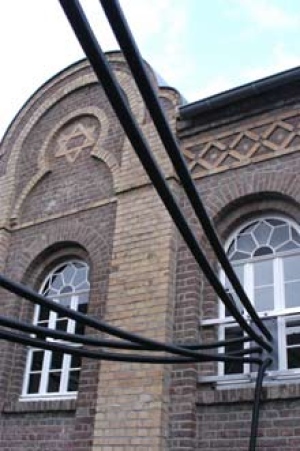 In March 2006, performance artist Santiago Serra constructed a homemade gas chamber inside a former synagogue in the Cologne area and invited Germans to be symbolically gassed. Exhaust pipes from six cars were hooked to the building, which was then filled with deadly carbon monoxide and visitors entered the space wearing protective masks. What was the artist’s intention? Serra said his aim was to give people a sense of the Holocaust. The Jewish community was furious. It was considered a provocation at the expense of Holocaust victims, an insult to survivors and the whole community. “What’s artistic about attaching poisonous car exhaust into a former synagogue?” said writer and Holocaust survivor Ralph Giordano (1923-2014), “and who gave permission for this?”
In March 2006, performance artist Santiago Serra constructed a homemade gas chamber inside a former synagogue in the Cologne area and invited Germans to be symbolically gassed. Exhaust pipes from six cars were hooked to the building, which was then filled with deadly carbon monoxide and visitors entered the space wearing protective masks. What was the artist’s intention? Serra said his aim was to give people a sense of the Holocaust. The Jewish community was furious. It was considered a provocation at the expense of Holocaust victims, an insult to survivors and the whole community. “What’s artistic about attaching poisonous car exhaust into a former synagogue?” said writer and Holocaust survivor Ralph Giordano (1923-2014), “and who gave permission for this?”
 The understandable outcry from Serra’s exhibit was very similar to the one we are witnessing today from the Dakota community in response to the gallows-like artwork recently installed for the refurbished Walker Art Center’s Sculpture Garden. While “Scaffold” artist Sam Durant and Serra draw inspiration from acts of extreme violence that are different in nature and scope, the lessons to be learned from both cases are the same: art that addresses mass atrocity is always demarcated by limits. It’s unfortunate that this lesson was blatantly ignored by the Walker’s curators.
The understandable outcry from Serra’s exhibit was very similar to the one we are witnessing today from the Dakota community in response to the gallows-like artwork recently installed for the refurbished Walker Art Center’s Sculpture Garden. While “Scaffold” artist Sam Durant and Serra draw inspiration from acts of extreme violence that are different in nature and scope, the lessons to be learned from both cases are the same: art that addresses mass atrocity is always demarcated by limits. It’s unfortunate that this lesson was blatantly ignored by the Walker’s curators.
The Holocaust has prompted a long history of ethical and aesthetic debates regarding the appropriate ways to represent unspeakable events whose reverberations we are still surrounded by. Filmmaker Claude Lanzmann, the brilliant creator of Shoah (Holocaust), said once in an interview that it is impossible to convey a certain absolute horror and that claiming to do so is to be guilty of the gravest transgression. The Holocaust, he argued, “erects a ring of fire around itself, a boundary that you cannot cross.” Lanzmann’s aesthetic approach was to give voice to the victims through survivor testimony, producing a filmic work of art that purposefully avoided using images of gas chambers or any documentary footage of the annihilation. By doing so he drew the boundaries of what could and what should under no circumstances be shown.
Today, can we conceive of art on atrocity without acknowledging its representational challenges? Unlike other subjects of artistic creation, here dubious approaches or failed experiments will not just be deemed of poor quality or taste, but an insult to the memory of surviving victims. The damage that such transgressions cause, both for those who carry the burden of historical trauma and for the relations among communities torn by divisive pasts, should never be underestimated.
The Walker controversy points to a broader problem: that the art industry is at constant risk of becoming no more than voyeuristic elitism. Too often art appropriates and exploits extreme experiences and turns them into a consumer product. Certainly, artists and curators will always claim an enlightening goal. Durant and the Walker Art Center have issued statements where they side with the plea of Dakota Indians for justice and acknowledgement. “Build awareness,” “start a conversation,” “it warns against forgetting the past,” in Durant’s words. Their purpose was candid and benign. But as an old saying goes, the road to hell is paved with good intentions.
If “Scaffold” was meant to start a conversation about past atrocities, but doesn’t engage the Dakota, in the end not much has changed. It’s still perpetuating a one-sided narrative.
Alejandro Baer is Associate Professor of Sociology and Director of the Center for Holocaust and Genocide Studies at the University of Minnesota.
Joe Eggers, is a 2016 graduate of the University of Minnesota. His MA thesis explored the cultural genocide of indigenous people through the boarding school system. He currently works as a research associate at the Center for Holocaust and Genocide Studies.

Comments